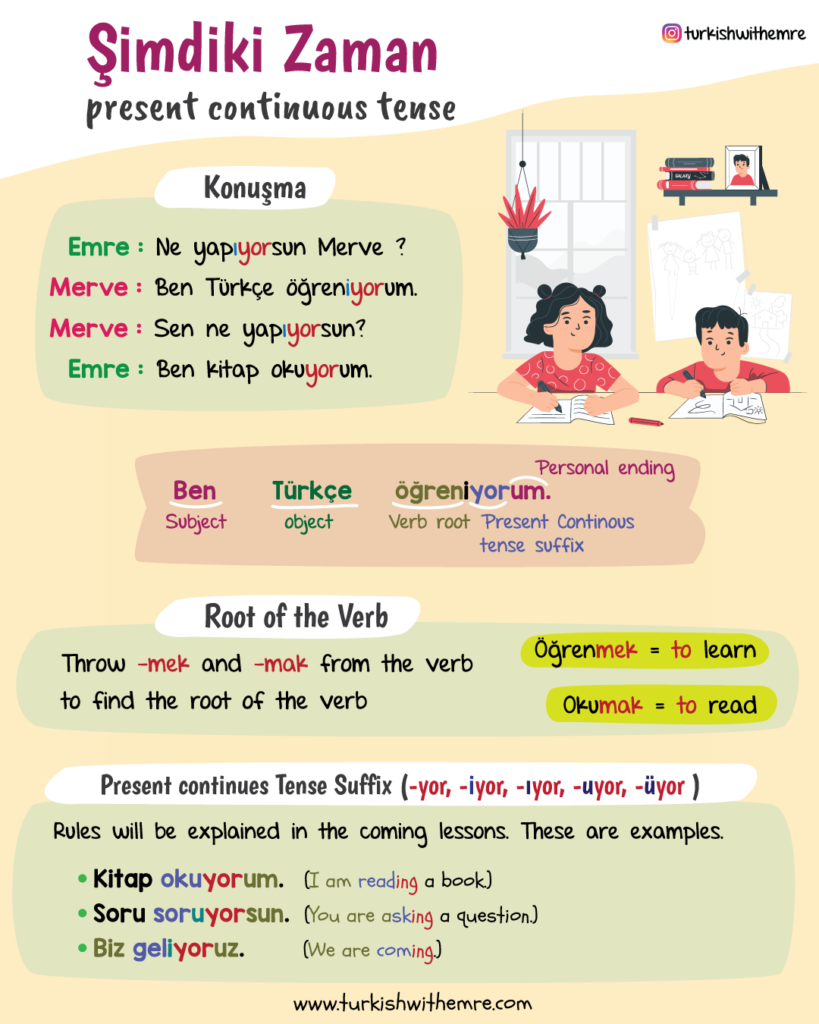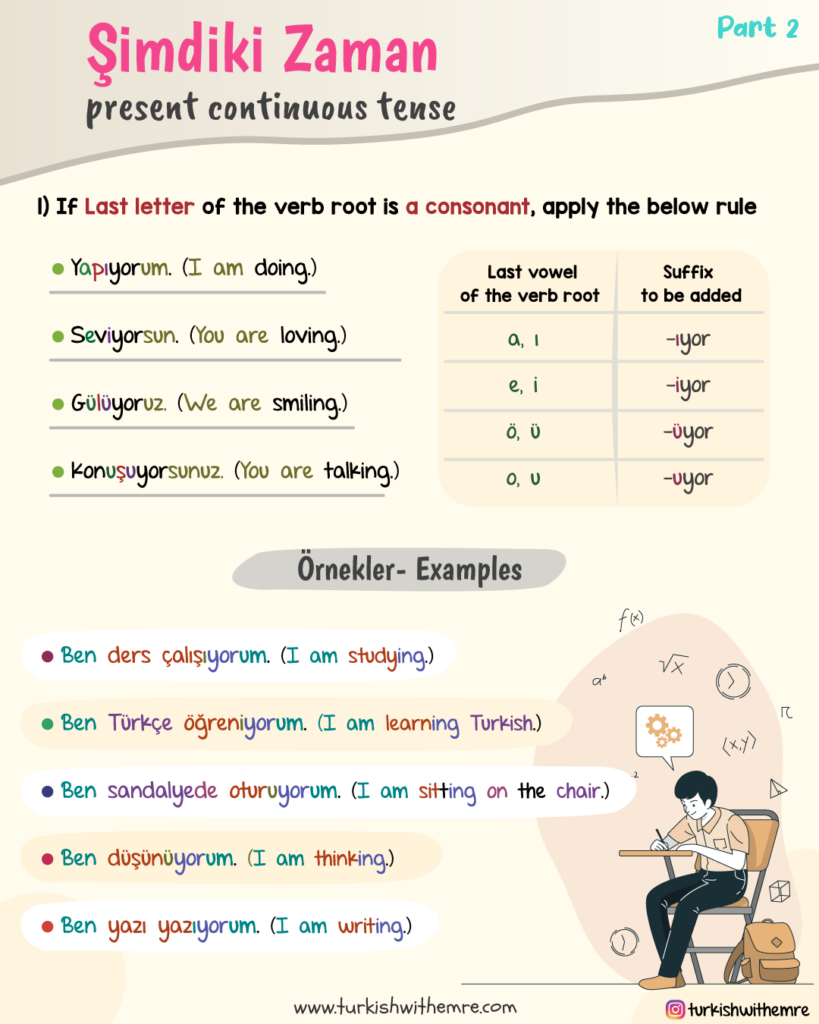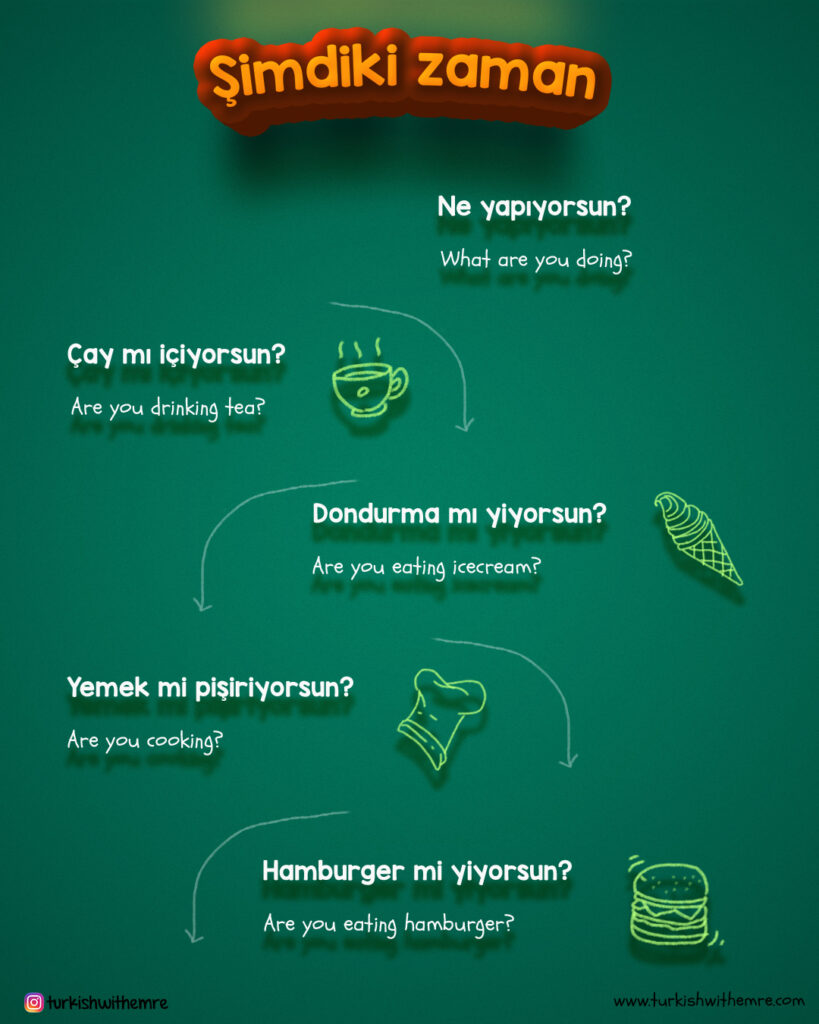Present Continuous Tense in Turkish
In this Grammar lesson, we will learn present continuous tense in Turkish. Present continuous tense means “Şimdiki Zaman” in Turkish. It is also essential Grammar lesson for Turkish beginners.
This is the complete Turkish grammar lesson for the present continuous tense. Follow each step slowly and carefully. Solve the exercises at the end of the lesson.
” – yor ” Suffix for Present continues Tense in Turkish
–yor is suffix is present continues tense. Look at the below examples to see how suffix is used in present continuous tense in Turkish.
| -yor | Present continuous tense suffix |
| -ıyor, -iyor, -uyor, -üyor | To preserve the vowel harmony, sometimes we need to use them . Rules will be explained below. |
- Ben kitap okuyorum. (I am reading a book.)
- Sen cevap veriyorsun. (You are giving answer.)
- O soru soruyor. (He / She is asking question.)
- Biz geliyoruz. (We are coming.)
- Siz çay içiyorsunuz. (You are drinking tea.)
- Onlar yürüyorlar. (They are walking.)
- Kedi bakıyor. (Cat is looking)
Present Continuous Tense Word Order
Look at the below picture to see how is the structure of present continuous tense in Turkish.

Lets try to write “We are drinking tea” in Turkish together.
| Steps to build a sentences | |
|---|---|
| İçmek | Our verb is “İçmek : Drink” |
| İç | Root of the verb is “İç” |
| İçiyor | Add the present continuous suffix (-yor, -ıyor, -iyor, -uyor, -üyor) |
| Biz içiyor | Who is the subject? Ask ” Kim – Who” to the verb to find the subject. |
| Biz içiyoruz. | Our subject is “Biz”. Appropriate personal ending is “-uz” |
| Biz çay içiyoruz. | Ask ” Ne – What” to find the object and place the answer before the verb. |
Rules
In the previous given examples, you possibly have seen rules. These will be explain here in detail.
1 – If the root of the verb ends with vowel, you don’t need to do anything special. Just add the “-yor” after the root of the verb to build a sentence in present continuous tense.
Look at the below examples.
- Okuyorum. (Okumak – To read)
- Yürüyorsun. (Yürümek – To walk.)
2- If the root of the verb ends with consonants, to preserve the vowel harmony in Turkish, we need to use one of the given suffixes ” -ıyor, -iyor, -uyor, -üyor“
Possibly you ask now how to choose the correct one. Here all the necessary information about that.
General rule about this to preserve the vowel harmony in Turkish. Actually, if you try to say fast verb of the root and suffix “-yor” , you will easily which one needs to be chosen. But in any case, ı will share with you the rule below.
- Yapıyorum. (Yapmak – To do)
- Taşınıyorsunuz. (Taşınmak – To move in)
- Geliyorum. (Gelmek – To come)
- İçiyorsun. (İçmek – To drink)
- Ölüyor. (Ölmek – To die)
- Gülüyorum. (Gülmek – To laugh)
- Soruyoruz. (Sormak – To ask)
- Konuşuyorsun. (Konuşmak – To talk)
| Last vowel of the verb root | Suffix to be added |
|---|---|
| a, ı | -ıyor |
| e, i | -iyor |
| ö, ü | -üyor |
| o, u | -uyor |
3 – If the root of the verb ends with “a , e” , they need to turn into “ı, i, o, ü”. Reason is again to preserve vowel harmony.
- Anla– yor -> Anlıyor (Anlama – To understand)
- Ekle – yor -> Ekliyor (Eklemek – To add)
- Yaşa– yor -> Yaşıyor (Yaşamak – To live)
EXERCISES
[qsm quiz=30]
You can visit the Turkish vocabulary page for more Turkish vocabulary lesson.
For support and learning Turkish easily with colorful pages, you can buy the book for Turkish for beginners from the shop.
Vectors in this page designed by freepik www.freepik.com




